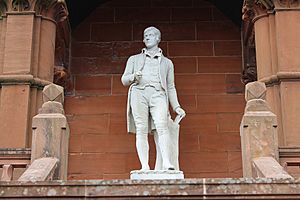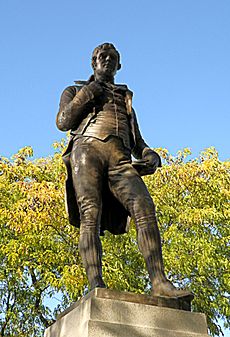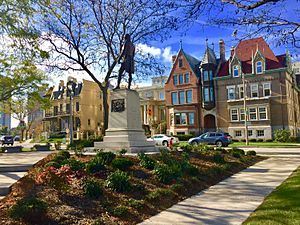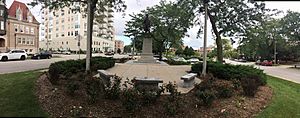Statue of Robert Burns (Milwaukee) facts for kids
Quick facts for kids Robert Burns |
|
|---|---|
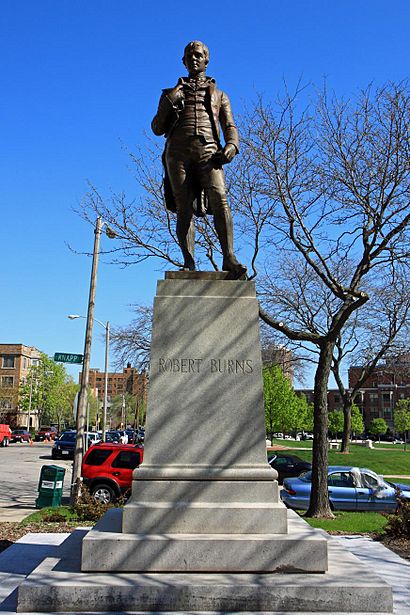 |
|
| Artist | William Grant Stevenson |
| Year | 1909 |
| Type | bronze |
| Location | North Prospect Ave. and East Knapp St., Milwaukee |
| 43°02′48.0″N 87°53′48.5″W / 43.046667°N 87.896806°W | |
The Robert Burns statue in Milwaukee, Wisconsin, is a famous piece of public art. It is also known as the Burns Monument. This bronze statue shows the Scottish national poet Robert Burns. It was created by the Scottish artist William Grant Stevenson. The statue stands on a tall base, called a plinth. This plinth is made of pink granite from Nova Scotia. It also has two bronze panels with carvings on them. A man named James A. Bryden gave this monument to the City of Milwaukee.
Contents
Meet the Sculptor: William Grant Stevenson
William Grant Stevenson was a very busy Scottish sculptor. He was part of a special group of artists called the Royal Scottish Academy. He became a member in 1896.
Stevenson first became famous for his statues of Robert Burns in 1879. His marble statue was chosen as the best for the Burns Monument in Kilmarnock, Scotland. He worked in Edinburgh with his brother, David Watson Stevenson, who was also a sculptor. William Grant Stevenson is also known for his huge bronze statue of Sir William Wallace in Aberdeen.
Stevenson's statues of Burns in Kilmarnock and Milwaukee look similar. But if you look closely, you can see differences. For example, their arm positions and hand gestures are not the same. The Kilmarnock statue is made of marble. The Milwaukee statue was made by pouring melted bronze into a mold. You can find other Burns statues by Stevenson in Denver, Chicago, and Fredericton, New Brunswick.
Statue Details
The Bronze Figure
The bronze statue shows Robert Burns standing. He faces south and holds a notebook in one hand. The statue makes Burns look like he did in paintings by Alexander Nasmyth. These paintings show the poet as a young man.
Burns wears a "claw-hammer" coat, knee breeches, and a vest. He also has a cravat and woolen socks. In his left hand, he holds a notebook with his fingers between the pages. In his right hand, he holds a quill pen.
The statue was made in Edinburgh. It was then shipped to New York in December 1908. From there, it traveled to Milwaukee.
The Burns Monument has a bronze statue and two bronze carvings. It also has a granite base with words carved into it. All four sides of the base have carvings. The bronze panels are on the west and east sides.
Bronze Carved Panels
The bronze panels on the Burns Monument are in a style called bas relief. This means the carvings stick out slightly from the flat surface.
The western panel is called Burns at the Plough. It shows the poet resting his horses while plowing a field. The eastern panel is called A Cotter's Saturday Night. This panel shows a scene from one of Burns's famous poems.
Important Inscriptions
The front of the statue's base simply says: ROBERT BURNS
The back of the base tells who gave the gift: THE GIFT OF JAMES ANDERSON BRYDEN A NATIVE OF SCOTLAND TO THE CITY OF HIS ADOPTION 1909
Under the western panel, the base has these words: THE POETIC GENIUS OF MY COUNTRY FOUND ME AT THE PLOUGH AND THREW HER INSPIRING MANTLE OVER ME
Under the eastern panel, you can read: FROM SCENES LIKE THESE OLD SCOTIA'S GRANDEUR SPRINGS
Statue Location
The Burns Monument is in Burns Commons in eastern Milwaukee, Wisconsin. It stands in a triangular park. This park is called the Burns Triangle. It is bordered by North Prospect Ave., East Knapp St., and North Franklin Pl. James A. Bryden helped choose this spot for the statue. Other city officials and local leaders also helped decide.
The Generous Donor
James Anderson Bryden gave the Burns Monument to Milwaukee. He was a Scottish immigrant. He was born near Lockerbie, Dumfriesshire, Scotland. His family moved to the United States in 1840. They first lived in Utica, New York.
In 1857, his family moved to Milwaukee. James Bryden started working in the grain business. He spent his early years working on a farm. This farm experience later helped him meet Abraham Lincoln. His time on the farm also made him love Robert Burns's poems. Burns was known as the "Ploughman Poet" in Scotland. A photo of Bryden at the monument was in the newspaper before it was officially shown. News reports said his favorite Burns poem was "A Cotter's Saturday Night."
Unveiling Ceremony
The Burns Monument was officially shown to the public on Saturday, June 26, 1909. The ceremony started at 2 PM. Hundreds of people gathered and walked in a parade to the monument. The Caledonian Pipe Band led the way.
A minister, Rev. Frederick Edwards, gave a prayer. The Lyric Glee Club sang a Burns song. Andrew D. Agnew gave opening remarks. Miss Juneau Theiline McGee unveiled the statue. She was the great-great-granddaughter of Solomon Juneau, Milwaukee's first mayor. About 2,000 people came to the ceremony.
Judge Joseph V. Quarles gave a speech about Robert Burns. He then officially gave the monument to the City of Milwaukee. Mayor David Stuart Rose accepted the monument for the city. The Lyric Glee Club sang another famous Burns song, "Scots Wha Ha'e." Other speakers also gave talks about Scottish culture and poetry.
Then, people in the crowd asked to hear from James Bryden. He spoke to everyone there:
Mr. Chairman, Ladies and Gentlemen: It gives me great pleasure to greet this large gathering of our citizens and our friends from Wisconsin and other States. You are assembled to witness the unveiling of a statue in memory of the ploughboy poet, Robert Burns, whose songs are sung in every land and in every tongue. His writings are dear to all Scotsmen, wherever found. It was my good fortune to be born in Scotland, and to come to this country with my father's large family when I was five years of age. My father bought a farm near Utica, New York, and I remained on that farm until I was past twenty-one years of age, when I came to Milwaukee, in 1857. My business life has been passed in this beautiful and prosperous city. It gives me great honor to present to the City of Milwaukee this monument of Robert Burns, the world's great poet, the poet of humanity.
The ceremony ended with everyone singing the well-known Robert Burns song, "Auld Lang Syne."
Caring for the Monument
James Bryden was the President of the Saint Andrew's Society of the City of Milwaukee from 1898 to 1899. Members of this society have helped take care of the Burns Monument for many years.
Because the monument is old, it needs regular care. This includes cleaning the statue and putting on a new protective layer. In 1987, a newspaper article talked about how some statues in Milwaukee, including the Burns statue, were in bad shape.
In 1994, several groups helped pay for cleaning and restoring the monument. These included the Saint Andrew's Society and the Burns Club of Milwaukee. A skilled conservator, Douglas D. Kwart, was hired to do the work.
A special ceremony was held on August 28, 1994, to celebrate the restored monument. People from the Milwaukee County Government, Parks Department, Saint Andrew's Society, and the local Scottish community attended.
Burns Triangle Park Improvements
In 2010, the Saint Andrew's Society worked with the Milwaukee County Parks. They raised money to add a walkway around the statue. This walkway is made of granite pavers with special messages carved into them. Now, visitors can walk close to the statue. They can see the carvings and panels without stepping on the rose bushes or flower beds.
In 2013, granite benches were also added to the Burns Triangle. These benches were donated and installed with the help of Milwaukee County Parks. They let visitors sit and enjoy the statue. The benches even have lines from Burns's poems carved into them.
Annual Wreath-Laying
Every year, a special ceremony is held at the monument. People place a wreath at the statue. This ceremony usually starts at 2:00 PM. It happens on the Sunday closest to Robert Burns's birthday, January 25.
Local Scots, fans of Burns, and members of the Saint Andrew's Society gather. They celebrate by reading poetry, playing the bagpipes, and singing Burns's songs.


